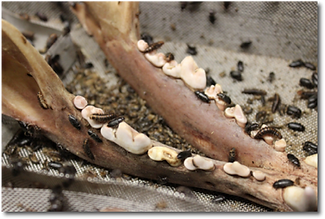

Paleobiology & Geobiology Research Group
at Virginia Tech
Resources

Because our research is based on questions developed through our fieldwork, we have field and laboratory resources for exploring the fossil record. For more details about the fieldwork conducted through the Paleobiology & Geobiology Research Group, see Dr. Xiao’s, Dr. Nesbitt’s, and Dr. Stocker’s individual pages on the many field-based projects in which they’re involved. As a group, we have several spaces in Derring Hall for our research. We have multiple state-of-the-art facilities, including a specimen preparation lab, a histology and thin section lab, an imaging lab, a micropaleontology lab, a meeting room, and a dissection lab.
Interested in volunteering? Contact Dr. Nesbitt, Dr. Xiao, or Dr. Stocker to learn how to get involved!
Specimen Preparation
Specimen Preparation
Our research group examines both micro- and macrofossils, as well as extant taxa, to understand the evolution of Life. To address the range in sizes of our fossils, we have a rock processing laboratory with large and small rock saws and rock crushers. We also have the ability to use acid preparation (a maceration hood for handling acetic and hydrochloric acids) to extract microfossils and to dissolve the matrix surrounding bone. The tiniest of microfossils can be prepared for further analysis and imaging using a Servo 7150 press driller and Merchantek micromilling system.
In our paleontology preparation laboratory space we are able to do mechanical preparation of vertebrate and invertebrate fossils using MicroJack airscribes as well as pinvises. Additionally we use chemical preparation. We also have molding and casting capabilities.

Specimen Imaging
We have many avenues for imaging fossils and other data. Currently available are a desktop SEM (see below), copy stand, and many microscopes (Wild dissection scopes, Olympus BX51 epifluorescence microscope, SZ1145 stereoscope with digital imaging capabilities, three-headed Olympus BX51 petrographic microscope, a Zeiss Axio microscope). We emphasize illustration of data and teach our students to do the same.
One of our goals is to image using new technologies. We are currently setting up a CT center at Virginia Tech, and once complete, we will have access to a new microCT as well as other CT equipment. We currently have multiple computer workstations (Aviso, Mimics) for processing the scans we have done at Duke University and UTCT. Furthermore, we have a 3D printer (Form labs Form 2) to create three-dimensional models of tiny fossils or other parts of fossil previously hidden in rock.
We also work with Virginia Tech libraries 3D Design Study to surface scan fossil specimens for digital reproduction. We use a Artec Spider.
Our program has access to the equipment at the well-maintained Virginia Tech Institute for Critical Technology and Applied Science (ICTAS). Equipment there includes a SEM and TEM.





Bone Histology Laboratory
To study how animals grew, we have a fully stocked, state-of-the-art histology lab and associated facilities. We have larger rock saws for processing and a slow-speed saw for fossil bone. Microscopes with imaging capabilities for histology slides are also available.



Dissection Laboratory
To understand the biology of extinct organisms, we study the biology, anatomy, and growth of extant organisms. Therefore, we dissect modern organisms to look at the interaction of skeletal tissues (muscles, vasculature, nerves, and bones) and create study skeletons cleaned through maceration or with dermestid beetle colonies (below left). We also house a growing comparative skeletal collection of extant taxa, particularly squamates from all over the world. Many of the species in the collection have growth series ranging from hatchlings to old adults.

Collections
We hold a small comparative collection at Virginia Tech of representatives of animal clades from nearly all time periods for research and teaching. Within the department, we have museum-grade specimen cabinets that hold recently collected vertebrate fossils from our multiple field sites, including localities in Wyoming, New Mexico, Arizona, China, and Tanzania. The nearby Virginia Museum of Natural History holds a strong collection of Triassic vertebrates and Tertiary marine vertebrates.


